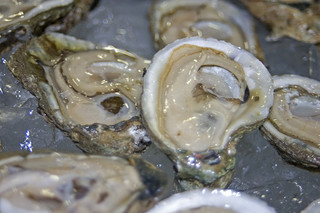Teaching Tired Old Turkey to Swim!
Holiday dinners usually feature ham and turkey. You may start having left-over sandwich nightmares after eating turkey for the next six weeks! Many Florida families choose fresh seafood as a delicious and healthy addition to their traditional holiday meals.

Fish on a thick bed of ice with bellies down. Courtesy of Florida Sea Grant
This is a great time of year to purchase and enjoy seafood. There is quality fish, shrimp, and shellfish currently at your local grocery store or seafood market. Usually with the holidays, there’s more time to explore new recipes in the kitchen. Fresh ingredients are the key to any good recipe and helps ensure healthy eating. The National Oceanic and Atmospheric Administration (NOAA) FishWatch website (www.fishwatch.gov) provides consumers with information regarding seafood nutrition, safety, and sustainability.
FishWatch suggests the following when shopping for fresh fish:
- To be sure the safety of seafood is being properly preserved, only buy fish that is refrigerated or properly iced. Fish should be displayed on a thick bed of fresh ice that is not melting and preferably in a case or under some type of cover. Fish should be arranged with the bellies down so that the melting ice drains away from the fish, thus reducing the chances of spoilage.
- Fish should smell fresh and mild, not fishy, sour, or ammonia-like odors.
- A fish’s eyes should be clear and bulge a little (except for a few naturally cloudy-eyed fish types, such as walleye pike).
- Whole fish and fillets should be firm and spring back when pressed.
- Fish should have shiny flesh and bright red gills free of slime. Dull flesh could mean the fish is old. Note: Fish fillets that have been previously frozen may have lost some of their shine, but they are fine to eat.
- Fish fillets should display no darkening or drying around the edges. They should have no green or yellowish discoloration and should not appear dry or mushy in any areas.
Fresh Florida Oysters are almost as popular during the holidays as pecans and walnuts; they are just a little more difficult to crack! Oysters are a welcomed addition to any meal, as side dishes, appetizers, or snacks between larger meals. You’ll enjoy finding great ways to prepare this nutritious shellfish.
Consumption of raw seafood such as oysters is not recommended for those whose immune systems are compromised. For example, patients completing chemotherapy or folks with blood or digestive disorders are at a higher risk for contracting bacterial infections. Ask your doctor if you have a question whether you are at higher risk. Properly cooked oysters (plump, opaque, and curled edges) are healthy choices. Cooking kills bacteria associated with raw seafood. For more information on oyster consumption and recipes visit http://safeoysters.org
One recipe that complements the traditional bird is oyster dressing. With this recipe you can enjoy both turkey and seafood together. For more oyster and seafood recipes like this one, visit www.fl-seafood.com

Complement a traditional holiday meal with seafood dish like oyster dressing. Courtesy of Florida Dept of Agriculture and Consumer Services (FDACS)
Ingredients:
12-ounces Florida oysters
½ c. Florida celery, chopped
½ c. Florida onion, chopped
¼ c. butter
4 c. day-old bread cubes
1 tbsp. fresh Florida parsley, chopped or 1 tsp. dried parsley
1 tsp. sage
½ tsp. salt
1/8 tsp. poultry seasoning
1/8 tsp. teaspoon pepper
Preparation:
Preheat oven to 325° F. Drain oysters; reserve liquid. Remove any remaining shell particles. Chop oysters. Cook celery and onion in butter until tender. Add oysters and oyster liquid to vegetables; cook for 10 minutes. Combine oysters, cooked vegetables, bread cubes and seasonings in a large bowl; mix thoroughly. If stuffing seems dry, moisten with additional oyster liquid or chicken broth. Bake dressing in a greased casserole dish for 30 minutes.

